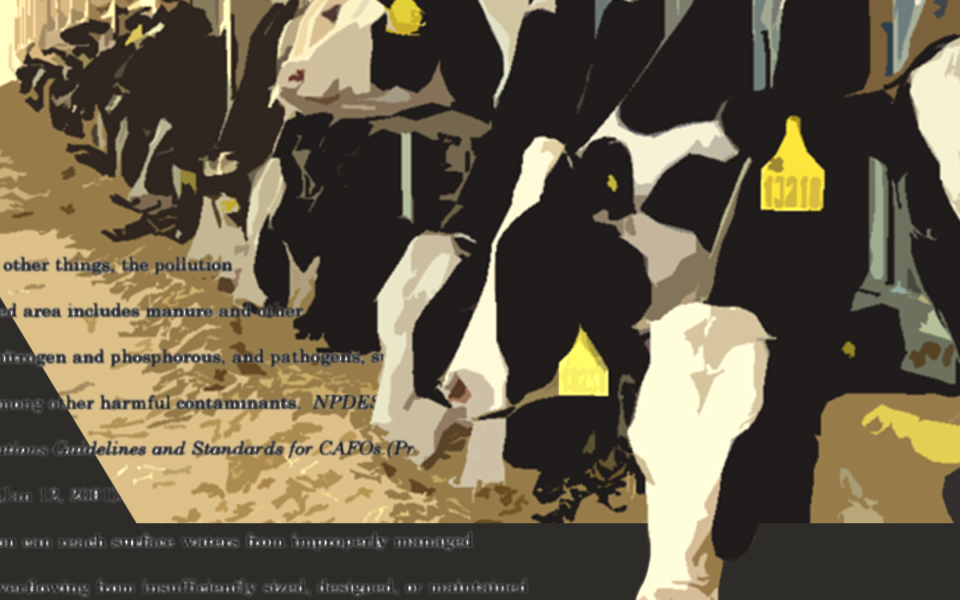Something’s in the Water: Litigation and Community Action Against Polluting Industrial Farms
Fatima Elhafiz Ibrahiem / August 5, 2022

This piece is part of our Student Blog Series, featuring posts on climate, clean energy, and environmental issues from the State Impact Center’s legal interns and other students working with the Center.
Key principles within the Environmental Justice (EJ) movement include the right to live in a healthy environment free of environmental toxins and the right to participate equally in environmental decision-making processes. The beginnings of the EJ movement can be traced to Warren County, North Carolina, when residents resisted the siting of a toxic polychlorinated biphenyl (PCB) waste dump in their community. More than four decades later, EJ communities in North Carolina and throughout the country are still dealing with the adverse consequences of living in environments saturated with hazardous pollutants, a consequence of being perpetually locked out of environmental decision-making.
Concentrated Animal Feeding Operations (CAFOs) are disproportionately placed in EJ communities that are already overburdened by other sources of pollution and waste in North Carolina. The Department of Agriculture defines CAFOs as industrial-sized livestock operations consisting of “more than 1000 animal units . . . confined on site for more than 45 days” a year. The animal waste produced by CAFOs is harmful to human health, often harboring pathogens like E. Coli, cryptosporidium, and salmonella. Studies indicate that living near industrial-scale hog operations may contribute to higher rates of kidney disease and anemia, exacerbate asthma symptoms, and possibly lead to premature death.
Contaminants found in animal waste like nitrogen and phosphorus may contaminate rivers, groundwater, and other water sources from spray fields where the waste is over-applied as fertilizer by farmers on crops. This is a practice that corrodes the ecosystems around it. The proliferation of toxic algal blooms that kill fish and other marine life across the country has been attributed to the nitrogen and phosphorus found in animal wastewater. Nutrient contamination occurs because of unlined lagoons and excessive fertilizer use that may easily seep into waterways during heavy rains.
EJ advocates in North Carolina have had some success fighting CAFO pollution, like when Duplin County residents won a major nuisance lawsuit in 2018 for the noise and odor pollution coming from lagoon waste and spray fields attributable to Smithfield Foods Inc., operator of some of the largest CAFOs in the state. However, some advocates are concerned that the Farm Act, subsequently enacted that same year in North Carolina, will eliminate hope of success for future, similar litigation by tightening conditions under which a plaintiff can succeed in a nuisance action against an agricultural operation.
Sherri White-Williamson, director and founder of the Environmental Justice Community Action Network (EJCAN), and Sampson County resident, has begun organizing and educating communities on hog farming practices and other environmental concerns. EJCAN conducts water testing to monitor water quality and convenes regular meetings with the public, among other actions which allow residents to understand the issues plaguing their community and know more about the sources of pollution that the community encounters.
Outside North Carolina, state attorneys general (AGs) have taken steps to address some of the problems caused by CAFOs in their states. In April 2022, Wisconsin AG Josh Kaul secured a $225,000 penalty from a CAFO operator in Kewaunee County for endangering public health by violating provisions of a wastewater discharge permit concerning management of land-spread manure. AG Kaul also won $55,000 from Verhasselt Farms for the discharge of pollution into state waters in violation of the operation’s water discharge permit, state laws, and other infractions. The judgment also included an order to “complete upgrades to two feed storage areas at the Outagamie County farm.”
In March 2022, Michigan AG Dana Nessel filed a lawsuit against Holloo Farms on behalf of the Department of Environment, Great Lakes, and Energy (EGLE), alleging its CAFO violated permit requirements as well as the Natural Resources and Environmental Protection Act (NREPA). AG Nessel also secured a $120,000 penalty, additional oversight, and increased permitting conditions in a Consent Judgment with Slater Farms for its operation’s pollution of the White River watershed with E. coli, nitrogen, and phosphorus, threatening the well-being of the Great Lakes. Though the monetary penalty may be partially waived with Slater Farms’ compliance with its operating permit, this is undoubtedly a step in the right direction towards disincentivizing CAFOs from polluting their surrounding environment.
Preventing CAFOs from harming people and the environment is an area where states have a lot of potential to change the landscape positively. States can enact regulations to keep the CAFO industry from despoiling the land, as well as legislation which empowers community autonomy over their environments. States can work with affected communities by supporting and partnering with established community organizations like EJCAN, or they may try to push for better conditions by litigating against CAFOs that violate the law. Meaningful regulation and oversight of this industry can ensure that everyone, especially EJ communities that are most vulnerable, are not further harmed by it.
This page was updated on March 5, 2024 to better meet our accessibility standards. To see the page as it was initially published, click here.
